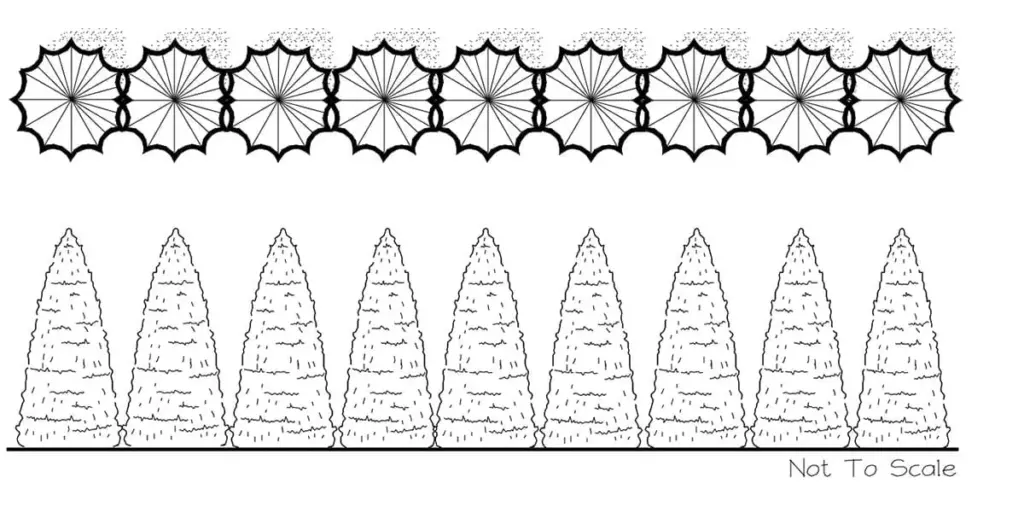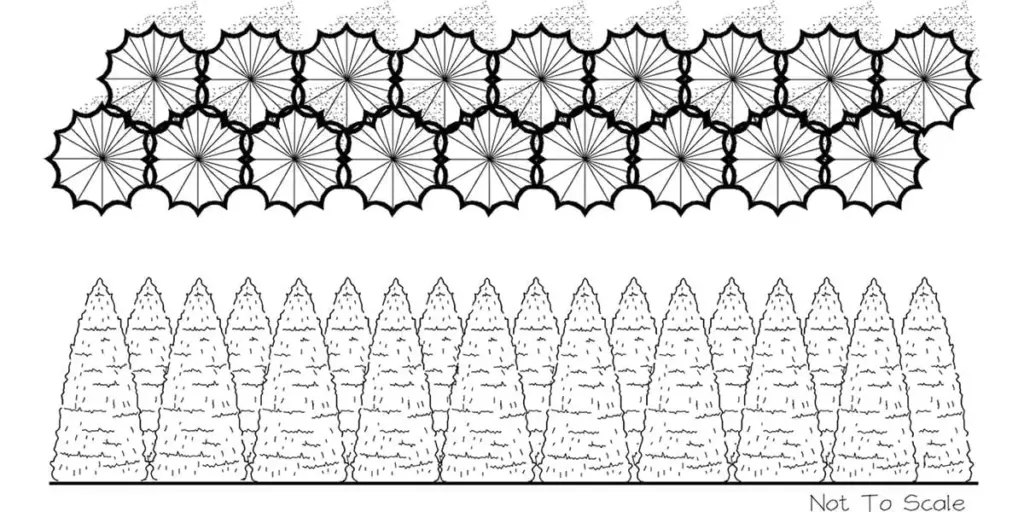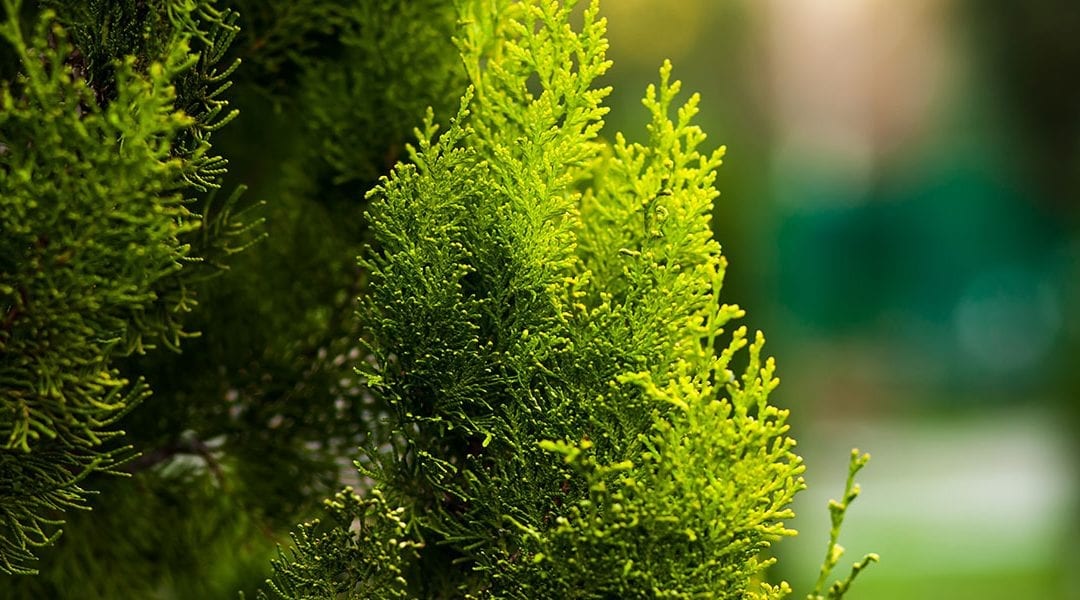Where can I plant arborvitae?
Arborvitae, or ‘arbs’ for short, prefer to be planted in full sun areas that receive 6+ hours of sun per day. However, several varieties can thrive in partial shade areas that get 4-6 hours of sun per day. Most arborvitae varieties do not like shady conditions; the more sun they get, the happier they will be. Lastly, be sure the area where they are planted does not have standing water during the season; arbs do not like having wet feet.
How many ‘Emerald Green’ Arborvitae do I need?
Many customers install arbs in long rows along their property lines to block neighbors, reduce noise pollution and hide unsightly views like roads and sheds. Regardless of size, Platt Hill Nursery recommends a spacing of 3′ from center-of-pot to center-of-pot. When using 3′ spacing, take the distance that needs coverage, say 30 feet, and divide that distance by 3 to get an idea of how many arbs are needed. So, 30 ÷ 3 = 10 arbs. Keep in mind, there will be small gaps in between each plant after installation, but the gaps will fill in after a few years.
If coverage is needed immediately, most arborvitae can be installed needle-to-needle or at whatever spacing is desired; they are meant to growth together to provide privacy coverage. Ultimately, the quantity needed depends on this question: are you willing to wait for the gaps to fill in or do you need coverage now?
Tip: When installing smaller quantities of plants, use ‘The Rule of Odds’ and plant in odd numbers like 1, 3, 5, 7, 9, & 11 for a more pleasing and natural look in the landscape.
How should I space the arborvitae?
Below are two common methods for spacing arborvitae – single row and staggered. Single row plantings will require a smaller planting bed, but may take longer to give you full coverage due to the gaps between the plants. Staggered rows, on the other hand, will give you more immediate coverage, but will require a deeper planting bed and can results in gaps between plants when not viewed from straight ahead.
Single Row

Staggered Rows

How should I plant arborvitae?
Please refer to our planting detail sheet available at the registers and on our website.
Tip: If planting in a low area that sometimes has standing water, install the arbs a little higher than normal. Dig about ½ to ¾ of the root ball into the ground, then mound a mixture of top soil and compost up the top of the root ball and gradually slope the soil away. By raising the root ball out of any possible standing water you give the plants a much better chance of survival.
Should I add anything to the soil when I install ‘Emerald Green’ Arborvitae?
Yes, Chicagoland soil typically has lots of clay and even gravel in some areas with a thin layer of top soil. Because of this, amending the soil is extremely important when installing ANY plant material – not just arborvitae trees. A mixture of top soil and One Step soil conditioner are vital to give plants a good start. Applying a 2-3″ layer of hardwood mulch on top will regulate soil temps, improve moisture retention and helps to keep weeds from growing. It also looks better than exposed soil.
How often should I water them?
Please refer to our ‘To Water or Not to Water?’ sheet available at the registers or follow the link.
After planting, continue to check the arborvitae’s water needs well into winter. This could mean watering in December and even January if we have a mild winter with very little snowfall and unseasonably warm days. Many customers stop watering their arbs in fall when the cooler temperatures arrive, and as a result, the plants dry up in winter from a lack of moisture. Arbs cannot utilize the frozen water in the ground during winter so be sure to apply plenty of water to new plants before temperatures drops.
Tip: Evergreens are slow to react and generally don’t show signs of water stress until well after the event has occurred. This is why regularly checking your soil for moisture needs is important.
How fast do ‘Emerald Green’ Arborvitae grow?
The answer to this question depends on multiple factors in your landscape. Water, sunlight, soil type, fertilizing schedule and weather conditions all play a part in the growth rate of arbs. Generally, categorized as having a medium growth rate; 6-12″ per year. Here in the Midwest, their growth cycle tends to be: fatten out, then grow up, fatten out, then grow up, and so on.
Tip: After installation, most evergreens take about 2 years to develop adequate root systems. The third year is when significant top growth is typically noticed.
How and when should I prune my arborvitae?
Pruning on ‘Emerald Green’ Arborvitae is rarely needed due to their growth rate and shape. However, if pruning is needed, the tops of arborvitae can be pruned to a point and the sides can be sheared back with a hedge trimmer or pruners to manage the width.
Platt Hill Nursery recommends pruning arborvitae in late winter before new growth emerges or after the new growth has developed in late spring. DO NOT PRUNE IN FALL. Any dead or broken branches can be removed throughout the year, even in fall.
The insides of my arborvitae are turning brown in fall. What’s happening?
Don’t be alarmed. This seasonal needle drop is normal for most evergreen trees. They drop needles that are 2-4 years old every fall as part of their natural growth process. If needle tips are browning, give us a call.
Important Information for Success
‘Emerald Green’ Arborvitae are very winter hardy Zone 4 plants. Once established, they provide years of reliable green beauty and screening. Often times, when planting arbs in large numbers, there is a tendency to cut corners in order to finish the job quickly. For maximum success, install each plant correctly by digging a proper sized hole, using the right soil amendments and watering regularly. Ultimately, installing arborvitae correctly and providing adequate water gives your plants the best chance of success.
Common Types of Arborvitae
- Green Giant Arborvitae – grows 2-3 feet per year, making it the ideal fast-growing privacy tree with a stately, uniform pyramidal shape.
- Emerald Green Arborvitae – a dense evergreen privacy tree, featuring a compact, pyramidal shape perfect for creating a lush, year-round screen.
- Holmstrup Arborvitae – A hardy, low-maintenance evergreen privacy tree with a narrow, upright form and lush green foliage, perfect for small landscapes.
- Technito Arborvitae – A compact, evergreen privacy tree with dense, dark green foliage and a refined pyramidal form, perfect for gardens and landscapes.
Platt Hill Nursery is Chicago’s premier garden center and nursery. Learn more about arborvitae varieties.
Downloadable Print Friendly Version Why is my evergreen turning brown?


